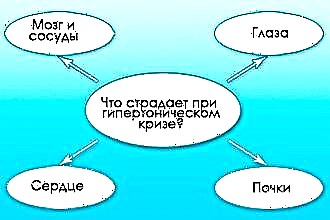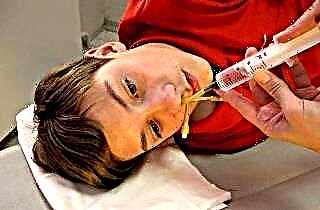Herpetic sore throat affects a person at any age. The development and course of the disease will depend on many factors. The Coxsackie virus is ubiquitous.
The clinical picture with herpangina is quite characteristic. The classic symptoms, according to Komarovsky, are sores on the tonsils, fever and anginal pain. With a reduced immune status (and with a high virulence of the pathogen), in weakened people and infants, there is a possibility of complications of the disease.
Etiology
 Herpes sore throat (herpangina, ulcerous sore throat, aphthous pharyngitis) is an acute infection. Manifested by fever, sore throat, vesicular (vesicular) lesion of the pharyngeal mucosa with the development of erosions.
Herpes sore throat (herpangina, ulcerous sore throat, aphthous pharyngitis) is an acute infection. Manifested by fever, sore throat, vesicular (vesicular) lesion of the pharyngeal mucosa with the development of erosions.
Herpetic (herpes) sore throat - Dr. E.O. Komarovsky advises to call it a lesion of the throat (its mucous membrane, tonsils and pharynx) enteroviral vesicular stomatitis or pharyngitis or herpangina.
The popular definition of "herpetic sore throat" is not entirely correct. It has nothing to do with either the herpes virus or the sore throat. The only generalizing point is similar rashes in the oral cavity, pharynx (herpetic rash) and sore throat (typical streptococcal infection). But the treatment of herpes sore throat will have significant differences from the treatment of viral herpes infections and streptococcal sore throat.
Characteristics of the pathogen
The disease is caused by the Coxsackie enterovirus of group A, less often of group B and echovirus. The natural source of the Coxsackie virus is patients in the acute period and convalescents (recovered and recovering). There have been cases of circulation of the pathogen among animals (pigs).
For viral sore throat, seasonal occurrence is characteristic - an outbreak of the disease is noted in the summer - autumn period. It is quickly transmitted from person to person, especially in large groups. One person can get sick, but the whole family can be infected, depending on the strength of the immunity of each person. The occurrence of the disease during pregnancy will not have a harmful effect on the health of the unborn child if the mother leads a healthy lifestyle and the disease passes easily.
Children 3 - 10 years old and people with a reduced immune status are more likely to get sick. Children under one year old get sick less often, due to maternal antibodies. The incubation of the virus in the body is 7 to 10 days.
Ways of transmission of the virus:
- Airborne - is of the greatest importance and distribution (according to Komarovsky). This is especially true for the spread of the virus among children in groups.
- Fecal-oral (dirty hands, contaminated food, in children - infected toys, nipples).
- Contact - discharge from the nose, mouth (with saliva, nasal mucus).
 A version is known that the transmission of the Coxsackie virus is carried out through water (bathing and swallowing water, getting into the nose) near the places of wastewater discharge (sewage).
A version is known that the transmission of the Coxsackie virus is carried out through water (bathing and swallowing water, getting into the nose) near the places of wastewater discharge (sewage).
The gates of infection are the mucous membranes of the oral cavity and intestines. Once in the body, the virus multiplies rapidly and spreads through the blood (viremia) throughout the body. The period of viremia is from 2 to 8 days.
Replication (multiplication) of the virus in the cell causes its edema and subsequent death. These continuous processes lead to the accumulation of a large number of such cells and the formation of necrotic areas that contain exudate. Later, the vesicles are opened, part of the viruses are transferred to the stomach, where they are destroyed by immune components.
Herpangina symptoms
The clinical picture in an adult and a child is similar. But an adult gets sick more easily. The disease is accompanied by a decrease in appetite, signs of general malaise. Children often have dyspeptic symptoms (diarrhea). This is due to the development of enterovirus in the intestinal tract, and therefore, the mucous membrane becomes inflamed, digestion is disturbed. A sick child complains of abdominal pain, nausea.
Herpetic sore throat often occurs as an acute viral respiratory disease with the accompanying characteristic vesicular rashes on the mucous membrane of the mouth and pharynx.
The clinical picture of the disease:
- A sudden increase in body temperature (fever) - up to 40 - 41 ° C, which is typical for this sore throat. The increase takes place in a short time - 2 - 4 hours.
A feature of hyperthermia with herpangine is a change in temperature (increase) in 2 doses - on the 1st and 3rd day (acute period) of the disease.
- Dysphagia and pain (acute) in the throat, which differs from typical anginal soreness - the pain does not squeeze the throat, does not radiate into the ear, but a tingling painful sensation arises, aggravated by touching the vesicles, while taking liquid or food.
- Acute coryza with signs of nasal congestion, cough.
- Increase in regional (ear, retropharyngeal, submandibular) lymph nodes.
 After the onset of the disease, small bubbles (papules) appear on the mucous membrane of the oral cavity (palate, tonsils, cheeks), which are filled with exudate (transparent liquid). Papules burst after 3-4 days, the vesicular fluid flows out, followed by their drying and the formation of crusts. The affected surface is inflamed, hyperemic and very painful. In the absence of a bacterial infection, the affected areas quickly regenerate and complete recovery occurs.
After the onset of the disease, small bubbles (papules) appear on the mucous membrane of the oral cavity (palate, tonsils, cheeks), which are filled with exudate (transparent liquid). Papules burst after 3-4 days, the vesicular fluid flows out, followed by their drying and the formation of crusts. The affected surface is inflamed, hyperemic and very painful. In the absence of a bacterial infection, the affected areas quickly regenerate and complete recovery occurs.
Symptoms of complicated sore throat:
- unilateral conjunctivitis;
- meningitis with concomitant trismus (spasm) of the chewing muscles, headaches;
- pyelonephritis;
- myalgia;
- heartache;
- encephalitis.
Attention! Such specific symptoms are rare, but require attention and immediate medical attention, especially for convulsive phenomena in herpes sore throat in a child.
Atypical form - signs:
- absence of papular rashes with obvious edema of the inflamed mucous membrane of the oral cavity, pharynx;
- recurrence of rashes (the rash appears several times during the period of the disease) - observed in people with reduced resistance.
In difficult cases, the development of herpetic sore throat provokes the appearance of diarrhea, vomiting. The entire period of the disease lasts up to 7 days in an adult and 8 to 10 days in children.
Attention! Herpes sore throat is not chronic and does not recur (does not recur).
Diagnosis of herpangina
The disease is diagnosed, taking into account the epidemiological situation and symptoms. A laboratory study of blood, nasopharyngeal swabs or intestinal contents is performed.
When a child is ill, his age is taken into account. Children under 3-4 years of age get sick with herpes sore throat more often than stomatitis.
Differential diagnosis
Differential diagnosis excludes herpes simplex, aphthous recurrent stomatitis, purulent sore throat.
Clinical differences:
- Purulent angina - a purulent rash is observed strictly on the tonsils, never affects the tissues outside of them. With the usual typical (ordinary) sore throat, a runny nose, nasal congestion (swelling of the mucous membrane) (as with herpes) does not occur.
- Catarrhal sore throat (similar to herpes sore throat without rashes - atypical form) - is not accompanied by rhinitis. The presence of a runny nose - the likelihood of developing a viral infection and herpes sore throat.
Herpangina is symptomatically different from stomatitis. Differentiation is carried out according to the dislocation of vesicles. With herpangin, lesions of the palate, tonsils, throat, pharynx (aphthous pharyngitis) are noted. With herpes stomatitis, there is a vesicular lesion of the tongue, gums, and the inner surface of the cheeks.
The course of the disease also has some differences. Herpangina proceeds with symptoms of intoxication (nausea, vomiting, dyspeptic symptoms), fever.Herpes-type stomatitis proceeds easily, rarely with a change in temperature (the exception is a complication of bacterial microflora) and without signs of general intoxication.
Herpetic sore throat Komarovsky claims that it differs from angina by the appearance of several vesicles (vesicles) with a large number of ulcers (on the tonsils, palate, cheek mucosa). Whereas with angina, there will be a noticeable lesion of the throat with pustules without the presence of ulcers.
It is worth paying attention to the fact that the acute period with herpangina lasts 8 - 10 days. With viral infections - 5 - 6 days, then the condition improves.
Treatment
There is no specific therapy for ulcerative sore throat. Symptomatic treatment is suggested, which is used to reduce pain.
- Antipyretic drugs are used - Nurofen, Paracetamol, Efferalgan, Aspirin.
- Provide plentiful and frequent drinking.
- Anesthetics are used - Hexoral-Tabs, Tantum-Verde, Teraflu Lar, 2% lidocaine solution (gargle).
- Rinsing the throat and mouth with medicinal broths (sage, chamomile, calendula) prevents bacterial microflora from joining in the focus of inflammation.
- Rarely used (but possibly with sensitization - allergies) antiallergic drugs - Claritin, Cetrin, etc.
- Diet food is recommended - mashed soups, liquid dishes, jelly, cereals.
Herpetic (herpes) sore throat, according to Dr. E.O. Komarovsky, has nothing to do with the herpes virus. Therefore, the use of antiherpetic drugs for the treatment of herpangina is impractical. https://casinoplay.com.ua/secrets-of-christmas/
Important! With herpes sore throat, dehydration should be avoided.
Fever, sweating, painful swallowing (unwillingness to drink), and intoxication contribute to the rapid loss of body fluids. The disease is treated with plenty of drinking and antipyretic drugs. Therefore, provide the patient with plenty of frequent drinking in small portions. On the advice of Komarovsky, you need to drink not warm, but cool (room temperature) teas, juices, decoctions, solutions for oral rehydration.
Doctor Komarovsky does not recommend topically treating the affected tissues with solutions (gentian violet, brilliant green, Lugol) when treating herpangina. This will bring additional pain and little healing effect. It is enough for a favorable course of the disease to create bed rest, provide adequate nutrition and plenty of drink.
It is not possible to shorten the course of the disease with medicines. You can only alleviate the patient's condition with them. The disease will end with the formation of immunity - after 7 to 10 days, not earlier.
Herpes sore throat often has a favorable prognosis - patients recover completely. There are rare cases of complications of the process in the form of meningitis, encephalitis, myocarditis.
Prevention of herpangina
There is no specific prophylaxis. Preventive methods are reduced to well-known principles:
- If possible, do not contact the sick.
- Create and observe the optimal microclimate parameters (in places of residence and work).
- To temper, practice a healthy, active lifestyle, strengthen immunity, walk more often and be in the fresh air, eat well.
- Adhere to the rules of personal hygiene.
Given the long period of the virus carrier, it is necessary to prescribe quarantine after 14 days after recovery.
Immunity
A person who has recovered from the Coxsackie virus develops specific immunity (to type A and B separately), which lasts for ten years. Therefore, a relapse of herpangina is practically impossible, the diagnosis will be correct - herpes stomatitis. It is possible to get sick with sore throat again only when infected with another type of virus, for example, B (if you have had an early type A) or after a long time, having lost specific immunity.
With stomatitis, cases of relapse are often noted, which indicates a weak immune status, which needs to be increased. This should be taken into account, since the treatment in both cases will have fundamental differences.
If signs of herpes lesions are often noted, you should consult a doctor. The specialist will help determine the reason for the decrease in immunity and tell you how to increase and strengthen it.



